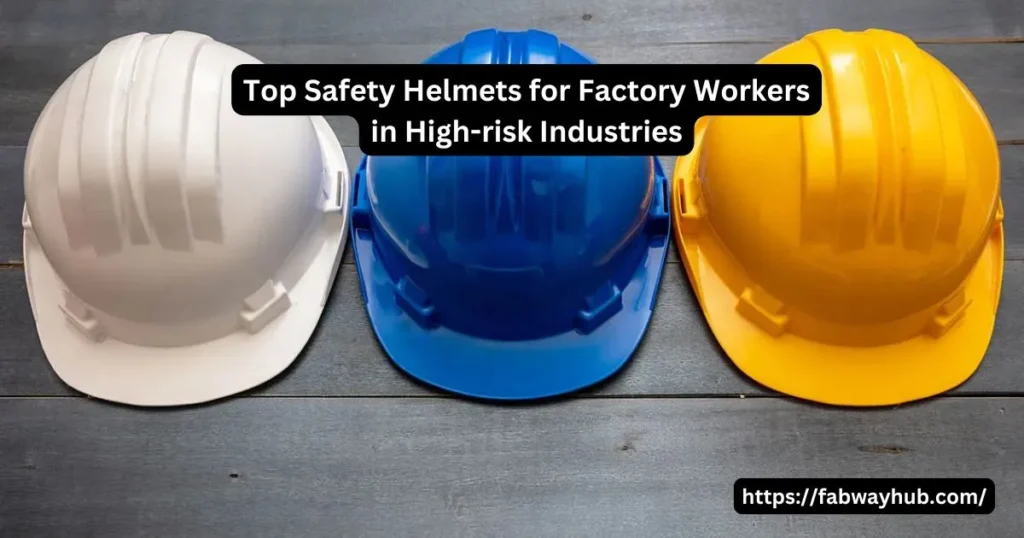Introduction
Safety helmets must not be an afterthought, most importantly when it is a high-risk industry where employees are exposed to possible danger every day. With the various hazards that a worker faces – falling debris, extreme heat exposure, electrical hazards, etc. – safety helmet specifically designed to handle and protect against these elements is an integral barrier against a potentially severe head injury. In this guide, we look at the best options of safety helmets for factory workers, and the key things you should look for when choosing a safety helmet for your team.
Why is Safety Helmet Crucial for Factory Workers?
Safeguarding Against Head Trauma
Accidents are not uncommon in environments such as construction sites or manufacturing plants, and they cannot be easily predicted. Falls can cause life-altering injuries in a split second. These helmets serve as a barrier absorbing impact and keeping the skull safe from trauma. For example, construction is a specific industry where machinery is commonly used, and cases are often reported in which helmets have saved lives, emphasizing safety.
Adherence to Occupational Health and Safety Standards
To keep employees safe from accidents, there are strict safety regulations imposed by both governments and organizations. Look for reliable helmets that meet industrial standards like ANSI or ISI, which would ensure suitable safety. Inability to follow these protocols can result in legal consequences and workplace accidents, which is an expensive concern for organizations.
Important Features to Look Out for in Safety Helmets
Material Quality
The material of a safety helmet is often a major factor in its durability. Common choices include high-density polyethylene (HDPE), ABS plastic, and polycarbonate. They’re lightweight, comfortable materials but also provide excellent impact protection.
Comfort and Fit
Employers, however, have wide authority to dictate the conditions of employing as they were trained as part of themhai. If your workers don’t wear their helmets or their helmets don’t fit well, it can lead to discomfort and a decrease in compliance. Seek adjustable straps, ergonomic designs and cushioned liners for long-term usability.
Ventilation and Design
For those that work in high-risk environments, this often translates into long hours in less than ideal conditions. And holes in the top of helmets and moisture-wicking liners help keep head heat from building up, meaning they can be worn for a long time.
Top Protective Headwear of High-Risk Industries
Construction workers need hard hats that can withstand falling debris and extreme weather. Popular choices include:
- 3M H-700 Series: Lightweight and UV resistant materials.
- Honeywell Peak A59 – Has a contrast-enhancing visibility strips.
Chemicals & Oil Industries Helmets
Such industries require heat and chemically resistant helmets:
- MSA V-Gard Helmet: Chemical resistant coating.
- Bullard C33: The best option for flame protection.
Helmets for the Electrical and Power Sector
Such as non-conductive materials for safety helmets in electrical industries:
- KARAM Shelmet: Affordable but reliable in electrical work.
- Honeywell E1RW Series: provides dielectric insulation for high-voltage work.
Well-Known Safety Helmet Brands in the Industry
3M Safety Helmets
3M is known for innovation in the field of safety, drawn on durability and comfort. Many of their products have UV protection and customized fittings, which are especially popular among construction workers.
Industrial Helmets | Honeywell Safety
Honeywell makes industrial safety helmet for almost any industry, including high-temperature and chemically hazardous situations.
MSA Safety Helmets
As a leading company in safety for industry, MSA provides helmets with advanced impact resistance, along with optional face shields for an additional layer of safety.

Things to Note When Purchasing Safety Helmets
Certification Standards
The converse of that is always watch for certifications like ANSI Z89. 1, EN 397 or ISI — so that the helmet meets the industry safety norms.
Helmet Lifespan
A safety helmet isn’t a buy once, cry once. Periods of exposure to sunlight, chemicals and physical stress can weaken its structure. Refer to manufacturer recommendations for replacing helmets or whenever noticeable damage occurs.
Cost vs. Value
It may be tempting to go for the cheapest option, but investing in your safety and helmet performance long term is worth it.
Safety Helmets Maintenance & Care
Cleaning and Storage
Use mild soap and water to clean helmets regularly. Steer clear of those heavy-duty cleaners that could damage the material. Keep them in a cool, dry place to ensure their integrity.”
Regular Inspection
Look for cracks, discoloration or worn-out straps on helmets. Routine checks make sure that you catch bids that could endanger the safety first.
Conclusion
In high-risk sectors, worker safety helmets are not just protective equipment—they’re life-saving instruments. With a grasp of the features, certifications, and maintenance practices, businesses can keep their workforce safe and healthy. The future pays off the talk, as the saying goes, and investing in premium safety helmets today translates into fewer accidents and higher productivity in the days and months ahead.
FAQs
How long do you expect a safety helmet to last in high-risk industry?
Safety helmets generally have a life span of 2-5 years if used correctly and protected from environmental factors.
Are safety helmets suitable for various types of work environments?
Yes, if they qualify to meet the standards specific to industries.
How often should helmets be checked for wear and tear?
They should be checked monthly and replaced at the first sign of deterioration.
How can I tell if a helmet is up to industry standards?
Seek certifications such as ANSI Z89. 1, EN 397, or ISI writing on the helmet.